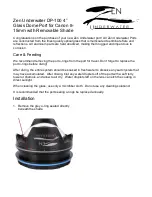FXTH870xD
Sensors
Freescale Semiconductor, Inc.
31
5
Reset, Interrupts and System Configuration
This section discusses basic reset and interrupt mechanisms and the various sources of reset and interrupts in the FXTH870xD.
Some interrupt sources from peripheral modules are discussed in greater detail within other sections of this product specification.
This section gathers basic information about all reset and interrupt sources in one place for easy reference. A few reset and
interrupt sources, including the computer operating properly (COP) watchdog and real-time interrupt (RTI), are not part of on-chip
peripheral systems, but are part of the system control logic.
5.1
Features
Reset and interrupt features include:
•
Multiple sources of reset for flexible system configuration and reliable operation
•
Reset status register (SRS) to indicate source of most recent reset
•
Separate interrupt vectors for each module (reduces polling overhead)
5.2
MCU Reset
Resetting the MCU provides a way to start processing from a known set of initial conditions. During reset, most control and status
registers are forced to initial values and the program counter is loaded from the reset vector ($DFFE:$DFFF). On-chip peripheral
modules are disabled and any I/O pins are initially configured as general-purpose high-impedance inputs with any pullup devices
disabled. The I bit in the condition code register (CCR) is set to block maskable interrupts so the user program has a chance to
initialize the stack pointer (SP) and system control settings. The SP is forced to $00FF at reset. The FXTH870xD has seven
sources for reset:
•
Power-on reset (POR)
•
Low-voltage detect (LVD)
•
Computer operating properly (COP) timer
•
Periodic hardware reset (PRST)
•
Illegal opcode detect
•
Illegal address detect
•
BACKGROUND DEBUG forced reset
Each of these sources has an associated bit in the system reset status register with the exception of the BACKGROUND DEBUG
forced reset and the periodic hardware reset, PRST, that is indicated by the PRF bit in the PWUCS1 register.
5.3
Computer Operating Properly (COP) Watchdog
The COP watchdog is intended to force a system reset when the application software fails to execute as expected. To prevent a
system reset from the COP timer (when it is enabled), application software must reset the COP timer periodically. If the
application program gets lost and fails to reset the COP before it times out, a system reset is generated to force the system back
to a known starting point. The COP watchdog is enabled by the COPE bit in SIMOPT1 register. The COP timer is reset by writing
any value to the address of SRS. This write does not affect the data in the read-only SRS. Instead, the act of writing to this
address is decoded and sends a reset signal to the COP timer.
The timeout period can be selected by the COPCLKS and the COPT[2:0] bits as shown in
Table 18
. The COPCLKS bit selects
either the LFO or the CPU bus clock as the clocking source and the COPT[2:0] bits select the clock count required for a timeout.
The tolerances of these timeout periods is dependent on the selected clock source (LFO or HFO).
Table 18. COP Watchdog Timeout Period
COPCLKS
COPT
Clock
Source
COP
Overflow
Count
COP Overflow Time
(ms, nominal)
2
1
0
0
0
0
0
LFO
2
5
32
0
0
0
1
LFO
2
6
64
0
0
1
0
LFO
2
7
128
0
0
1
1
LFO
2
8
256
0
1
0
0
LFO
2
9
512
0
1
0
1
LFO
2
10
1024
Содержание FXTH870 D Series
Страница 86: ...FXTH870xD Sensors 84 Freescale Semiconductor Inc Figure 57 Data Flow For Measurements...
Страница 170: ...FXTH870xD Sensors 168 Freescale Semiconductor Inc 19 Package Outline Figure 127 QFN Case Outline...
Страница 171: ...FXTH870xD Sensors Freescale Semiconductor Inc 169 Figure 128 QFN Case Outline...
Страница 172: ...FXTH870xD Sensors 170 Freescale Semiconductor Inc Figure 129 QFN Case Outline...
Страница 173: ...FXTH870xD Sensors Freescale Semiconductor Inc 171...


















